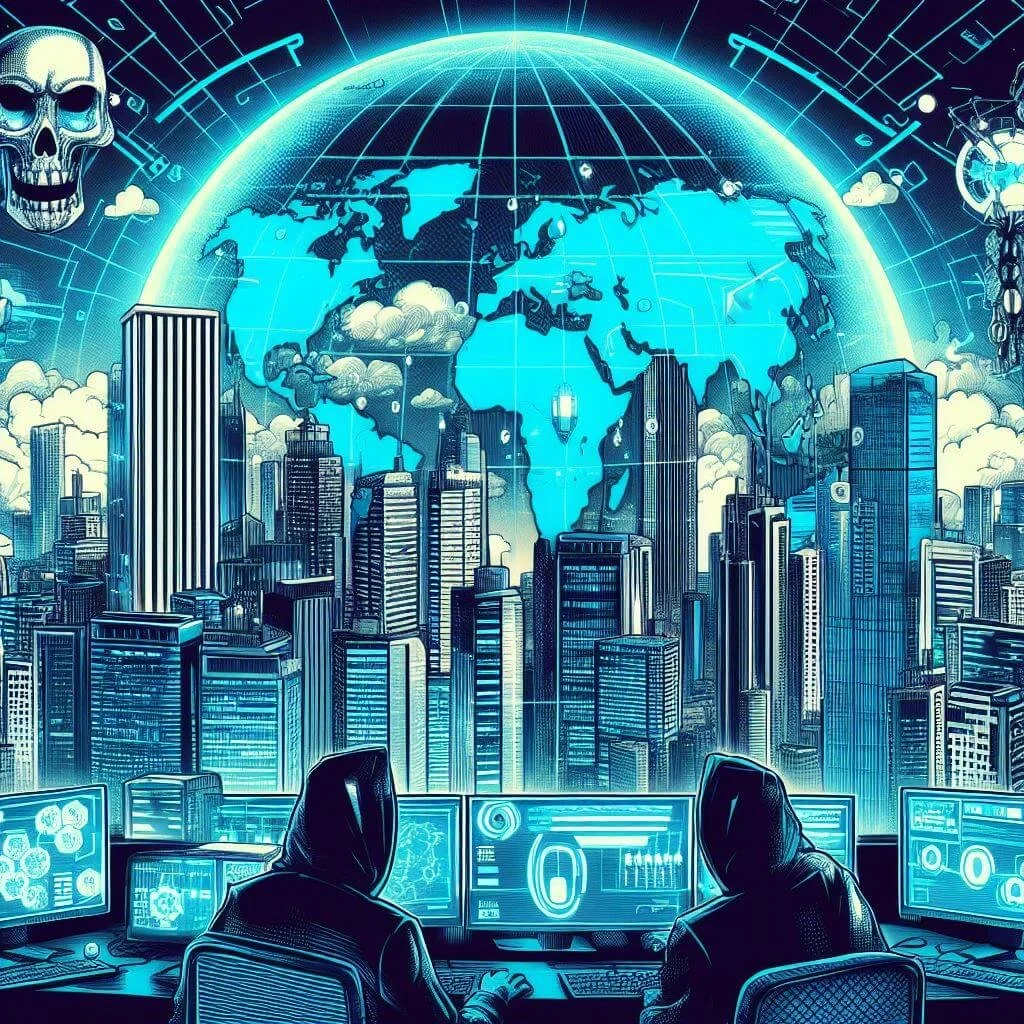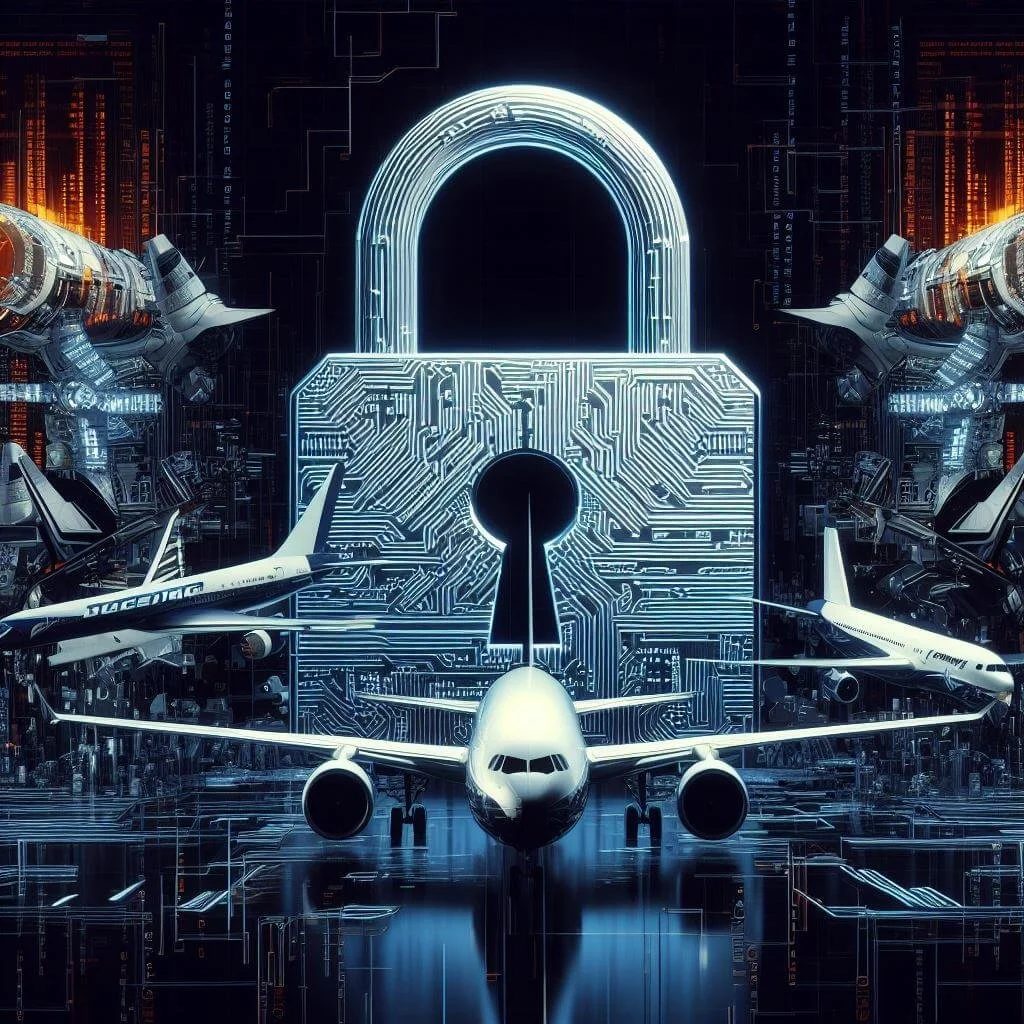Boeing Breach Exposes Cyber Extortionist Threat
Lockbit's Aggressive Attacks Spotlight Enterprise Risks
Global aerospace leader Boeing is investigating a cyberattack on its systems that saw sensitive company data leaked online this week. The breach has all the hallmarks of the notorious Lockbit ransomware gang, who claimed responsibility for infiltrating Boeing's network last month. This latest high-profile attack shows that no organization is safe from the escalating threat of cyber extortion.
Global cyber extortionist group Lockbit published 43 gigabytes of internal Boeing data earlier this month, highlighting the daunting challenge even security mature organizations face guarding troves of sensitive data.
This latest high-profile breach underscores that as long as ransomware remains profitable, digital extortionists will continue targeting enterprises holding valuable data.
And Lockbit epitomizes this profit motive. Lured by huge potential payouts, the ruthless syndicate has crippled giants in aviation, finance, infrastructure, and tech over the past year alone. With demands up to $100 million, Lockbit has effectively made the Forbes Global 500 its target list.
So how did a hacking group with suspected ties to Russian intelligence agencies manage to penetrate a massive US defense contractor and aerospace leader like Boeing?
Exploiting A Critical Vulnerability
Recently issued government advisories detail the anatomy of Lockbit's Boeing intrusion. Analysis reveals affiliation with past Lockbit infrastructure and tactics, techniques, and procedures (TTPs).
The first stage involved gaining initial access by exploiting a critical vulnerability in Citrix's NetScaler networking appliances. Tracked as CVE-2023-4966 and dubbed "Citrix Bleed," this remote code execution bug enabled unauthenticated attack of the web gateways many enterprises use for application delivery, optimizations, and remote access.
The bug essentially permitted Lockbit hackers to bypass password requirements and hijack authenticated user sessions. Through session takeovers, the threat actors could pivot laterally with elevated privileges, harvest credentials, and ultimately access sensitive data and systems.
Despite Citrix patching the flaw in October, Lockbit affiliates successfully weaponized the vulnerability before Boeing updated its appliances. Worse, a wider Citrix Bleed scanning campaign targeted vulnerable NetScaler installations more than 5,000 organizations operate globally. This scanning wave coincided with the spike in Lockbit intrusions.
Lockbit's Post-Breach Tactics
After gaining initial access via NetScaler, Lockbit affiliates quickly engaged an array of tactics to escalate privileges, harvest credentials, exfiltrate data, and deploy additional payloads.
Specific post-entry measures included:
Deploying credential harvesters like Mimikatz to extract passwords from memory
Obtaining Windows hashes and dumping LSASS process memory
Saving registry hives for offline credential cracking
Using legitimate system tools like PowerShell for lateral movement
Establishing encrypted tunnels for command and control (C2)
Installing implants like keyloggers and reverse shells for persistence
Compressing and staging data theft in cloud storage buckets
By chaining together these techniques, the threat actors mapped Boeing's systems, identified high-value data like personnel records and network diagrams, and prepared to launch the ransomware payload.
When Boeing refused a multi-million dollar demand, Lockbit followed through publicly leaking the pilfered files as retribution. But the full damage remains unclear amid ongoing digital forensics.
The Inevitability Of Compromise In A New Age Of Extortion
The Boeing breach illustrates the harsh reality that determined, well-resourced extortionists can infiltrate most enterprises at will until criminal hacking becomes an unprofitable venture.
While every organization should still enact cybersecurity fundamentals like patching, security training, and least privilege, compromise appears inevitable in the face of sophisticated social engineering, supply chain compromises, or zero-days.
Shoring up defenses remains vital but insufficient alone. Resilience now necessitates effective intelligence-driven threat hunting supported by elite cyber talent. We require security teams with the skills and technology to quickly detect and respond the moment a breach occurs.
Lockbit Mitigation Strategies From CISA
A recent government advisory outlines specific mitigations to help protect against Lockbit ransomware attacks.
Recommended actions include:
Isolating Internet-exposed appliances like VPNs and web gateways for patching
Implementing application allowlisting to block unauthorized software execution
Enforcing account lockouts after excessive failed login attempts
Applying phishing-resistant MFA across all remote access services
Upgrading PowerShell and enabling enhanced logging
Requiring privileged tasks to be approved by administrators
Maintaining updated backups and recovery images
Organizations should continually test defenses against known ransomware TTPs and address gaps revealed. Prioritizing visibility, automation, and cyber resilience reduces business disruption and costs when - not if - the inevitable occurs.
Turning The Tide Against Digital Extortion
The latest Lockbit strikes spotlight an uncomfortable truth - ransomware's asymmetric nature means most organizations remain outgunned despite sizable security budgets.
Insurers face immense losses from ballooning ransomware payouts, prompting coverage pullbacks for policyholders violating security standards. Insurers now increasingly deny coverage for victims lacking basic controls like endpoint monitoring, access management, and patching. Without coverage, many victims cannot finance business continuity after attacks.
Insurers should incentivize policyholders enacting controls like MFA, microsegmentation, deception tech, and AI-enhanced threat detection. Tax breaks could promote cybersecurity investments and cyber insurance purchases by small businesses.
Policymakers must also curb coverage for ransom payments protecting morally hazardous enterprises. Insurers can powerfully shape enterprise security postures by tying stringent controls to coverage.
But ending the extortion economy requires changing ransomware's risk-reward incentives by:
Cultivating elite threat hunting teams leveraging AI and deception tech
Pursuing assertive diplomatic and law enforcement actions globally
Restricting cyber insurance payouts funding criminal enterprises
Promoting stronger public-private intelligence sharing
We must also develop cyber-savvy workforces through education and training. Upskilling society is key to dismantling the ransomware ecosystem's very foundations - the profitability and safe havens enabling digital terrorism.
Join The Frontlines - Skill Up With StationX
StationX prepares cyber defenders with immersive training unlocking high-demand skills to combat threats like Lockbit.
Expert-led programs deliver hands-on mastery of ethical hacking techniques used by ransomware groups themselves - making you an adversary to be feared. Course modules include:
Penetration Testing and Ethical Hacking
Digital Forensics for Incident Response
Cyber Threat Intelligence
Security Operations and Analysis
Blockchain Analysis for Tracking Illicit Cryptocurrency
With graduates securing careers across industries, StationX is the elite launchpad for cybersecurity success.
The stakes couldn't be higher. Ransomware now poses catastrophic risks to healthcare, finance, infrastructure and public safety worldwide. But with the passion, knowledge and skills gained through StationX, you can help dismantle the criminal enterprises threatening civilization's digital foundations.
Extortion Economy Juggernauts
Lockbit has emerged as one of the most aggressive and disruptive ransomware syndicates in recent years. The group pioneered the ransomware-as-a-service model, effectively franchising its malware to empower affiliates to carry out attacks.
With over 1,400 victims globally and reported earnings of over $100 million paid in cryptocurrency ransoms, Lockbit reflects the alarming professionalization of cybercriminality. The group's brazen targeting of critical infrastructure like hospitals and banks has earned it notoriety.
Boeing now joins the ranks of enterprise giants crippled by Lockbit. The aerospace leader is still investigating the breach, but signs point to large amounts of sensitive data being compromised.
This attack should serve as a wakeup call - if ransomware extortionists can bring a company like Boeing to its knees, is any corporation safe?
When Titans Fall: Boeing's Breach and the End of Corporate Invincibility
Legacy titans like Boeing were long thought impervious to digital threats lurking in cyberspace's murky corners. But the unthinkable recently occurred - Boeing fell victim to a colossal data breach at the hands of a notorious extortionist gang.
This watershed cyberattack on a stalwart symbol of US economic might spotlights an uncomfortable new reality - virtually every organization is vulnerable to the predations of profit-obsessed criminal hackers.
Ruthless ransomware syndicates now perpetrate an epidemic of cyber extortion worldwide. But unlike analogues from fiction, these cyber gangs cannot be bargained or reasoned with. They are devouring corporate giants and critical infrastructure with impunity, fueled purely by financial upside.
Our analysis issues an urgent call to action - ending the scourge of ransomware demands cultivating new legions of elite cyber defenders.
When Titans Fall: Dissecting The Boeing Hack
Details are still emerging about one of the most stunning ransomware attacks in recent memory - the penetration of aerospace and defense colossus Boeing by brazen cyber extortionist crew Lockbit.
The genesis occurred in late October when Lockbit listed Boeing on its dark web data leak site, signaling a major new breach. Lockbit claimed to have exfiltrated vast troves of Boeing's data and issued multi-million dollar ransom demands.
When Boeing refused payment, Lockbit began leaking batches of stolen records. Experts describe the purloined files as largely administrative, not ultrasensitive designs or IP.
But sifting this data still grants valuable reconnaissance for orchestrating supply chain attacks on Boeing's vast partner ecosystem. And with investigations ongoing, the breach's full impacts remain uncertain.
This watershed attack lays bare alarming new truths - even security savvy giants are struggling to withstand the onslaught of ruthless ransomware gangs weaponizing every tool at their disposal.
Anatomy Of An Inevitable Megabreach
Forensic details reveal Boeing fell victim by a textbook ransomware playbook:
Initial Access: Exploiting an unpatched Citrix vulnerability (CVE-2023-4966) to breach the network perimeter
Execution: Conducting internal reconnaissance, harvesting credentials via Mimikatz
Lateral Movement: Using legitimate tools like PowerShell and WMI for lateral traversal
Exfiltration: Compressing terabytes of data and extracting it into the public cloud
Extortion: Issuing multi-million dollar ransom demands and threatening Boeing's brand via media leaks
The attack progressed rapidly once initial access was gained. Boeing's dilemma emerged - pay gargantuan ransoms or suffer data leaks, business disruption, plus lingering uncertainties.
An Insatiable Criminal Enterprise
The Boeing strike demonstrates Lockbit’s relentless opportunism. Lured by the promise of bigger payouts, the group sets its sights on large, deep-pocketed corporations.
In just the past year, Lockbit has also held operations hostage at aviation giant Boeing, Japanese automotive companies, Costa Rica's government, and tech consulting firm Accenture.
For ransomware syndicates, bigger targets mean bigger profits. In today's exploding extortion economy, no organization seems safe from digital shakedowns.
But Boeing’s refusal to pay Lockbit’s multi-million dollar ransom also shows that victims maintain some leverage. While cyberattacks remain inevitable, resilient security and contingency planning can limit damage.
No One is Immune from Cyber Extortion
Recent high-profile ransomware victims highlight the indiscriminate nature of these attacks across sectors:
Hospitals - Scripps Health, St. Joseph's/Candler Health System
Schools - University of California, Lincoln College
Energy Companies - Colonial Pipeline, Costa Rica's State Power Company
Tech Giants - Samsung, Nvidia, Microsoft
Manufacturing - Toyota, Honda
Food Companies - JBS Meats, Mondelez
Insurance Firms - CNA Financial, AXA
Transportation - Washington Metro, Honolulu Rail Transit
With seven-figure ransom demands becoming common, no organization can afford to ignore the risk.
The Anatomy of Ransomware Terrorism
Infiltration - Hackers covertly compromise networks via phishing, exploits
Encryption - Critical systems and data encrypted, halting operations
Extortion - Ransoms demanded in crypto to receive decryption keys
Intimidation - Stolen data leaked publicly to further coerce victims
The Criminal-State Nexus - Geopolitics Fan the Flames
Experts believe ransomware groups like Lockbit are harbored by nation states like Russia, which benefit from their chaos and deniability. This criminal-state nexus muddies responses and accountability.
With cyber extortion reaching crisis levels globally, experts are calling for assertive actions to deter attacks and shore up societal resilience.
Combating the Ransomware Contagion
"This demands a whole of society response. Everyone has a role to play."
- John Bambenek, Principal Threat Hunter, Netenrich
Ending the ransomware epidemic requires a collaborative multi-pronged strategy engaging government, industry, academia and society. Key focus areas include:
Policy - Global cooperation, cybercrime crackdown, cyber norms
Technology - Resilient systems, AI defense, cyber insurance reforms
Education - Cultivating cybersecurity talent and diversity
Resilience - Incident response, business continuity planning
Deterrence - Law enforcement and sanctions against hacker infrastructure
But ransomware groups continue operating with impunity, evolving their tactics faster than defenses. Stopping them requires aggressive disruption of their economic models.
The Cutting Edge - Next-Gen Cyber Defense
Emerging technologies like artificial intelligence and quantum encryption provide advanced capabilities against ransomware:
AI-powered defense - Machine learning for anomaly detection, automated threat hunting
Deception technology - Manipulate attacker perception with decoys and false data
Quantum-safe encryption - Unhackable cryptographic systems to protect data
Self-healing systems - Automatically recover compromised systems and data
Predictive intelligence - Data analytics and risk models to forecast vulnerabilities
But technology is only part of the solution. We desperately need more cybersecurity professionals.
Harbingers Of The Inevitable Compromise Age
The Boeing breach heralds an age where compromise is inevitable, especially when advanced hackers focus firepower on a target. Their success depends not on if networks will fall, but how profoundly.
While organizations must still enact cybersecurity basics, these are proving necessary but insufficient. Escalating attacks require the combination of resilient systems and threat visibility enabling rapid response when breaches invariably occur.
But obtaining this breach resilience may necessitate painful changes in enterprise business models and culture:
Making cyber risk quantification mandatory in planning and projections
Embedding security teams into engineering and product groups
Incentivizing cyber resilience and defense over feature velocity
Budgeting for breach response contingencies across divisions
Accepting short-term revenue declines from security updates disrupting operations
Enterprise organizations now require "always on" defense where constant vigilance and threat readiness supersede notions of impenetrable security.
The Existential Risks Of Ransomware
The Boeing breach underscores ransomware's existential threat to enterprises as criminals ramp up hacking automation, vascular persistence, and extraction of safety-critical data.
Attackers now coup de grace targets by encrypting backups, deleting system images, and sabotaging recovery mechanisms. Some have deployed ransomware modules targeting industrial safety sensors and physical infrastructure.
Without hyper-resilient architectures, many victims find themselves forced to pay gargantuan ransoms against crippling disruption of services or reputational carnage.
But refusing extortionists also necessitates immense response efforts as compromised environments require total rebuilds. The existential question stands - pay ransoms feeding serious crimes or absorb crushing incident costs?
Bracing For The Worst: Lockbit's Wrath
The particular ransomware collective penetrating Boeing - cybercrime faction Lockbit - ranks among the world's most aggressive extortionist gangs. Their signature is hitting victims with debilitating force just because they can.
Emerging from Russia's proliferating underground ransomware ecosystem, expert analysis ties Lockbit to past money laundering infrastructures affiliated with Evil Corp - a group allegedly connected to Russia's Federal Security Service (FSB).
Lockbit's core team manages relationships with dozens of "affiliates" granted access to their ransomware-as-a-service (RaaS) platform and tools. Profits split between syndicate and affiliates incentivize increasingly destructive attacks.
With over 1300 reported victims and at least $100 million earned in cryptocurrency ransoms, Lockbit has perfected the art of catch-and-release extortion:
Deploy vicious ransomware disabling critical systems
Issue extreme ransom demands failing systems restoration
Publish stolen data from victims refusing payment
This cycle maximizes payments from victims while using breached data to shame holdouts. Boeing attempted refusing their demands. But the company still suffered embarrassing IT architecture revelations enabling future supply chain attacks.
No Sector Immune: Ransomware's $265 Billion Bill
Lockbit's Boeing attack capped a year highlighting no industry evades the ransomware contagion:
Manufacturing: Lockbit crippled Taiwanese semiconductor titan TSMC's factories while Honda halted auto production globally after systems were encrypted.
Healthcare: Scripps Health saw cancer treatments postponed for weeks following systems paralysis. Ransomware delayed patient transfers as staff tracked vitals with paper records.
Critical Infrastructure: A petroleum ransomware attack shut the largest US fuel pipeline for days in 2021, sparking East Coast emergency declarations as gasoline stations saw panic buying.
Entertainment: Las Vegas icon Caesars Entertainment paid $15 million in ransoms across multiple 2021 cyber incidents. Sister property MGM rejected seven-figure extortion demands that year after guest and employee data theft.
Finance: Attackers breached the New York branch of Chinese banking giant ICBC last week, freezing Treasury market trades reliant on now compromised clearance systems.
The economic tolls inflicted by digital extortionists now register catastrophic, with estimated global damages from ransomware alone easily surpassing $265 billion in 2021 based on disruption and recovery costs.
Playing Financial Jenga: Ransomware's Profit Engine
What incentivizes mercenary ransomware cartels like Lockbit to escalate attacks exponentially despite risks? One word - money.
The profit model driving the global ransomware economy incentivizes increasingly aggressive intrusions into sensitive networks. Key financial engines include:
Cryptocurrencies: Enabling pseudonymous ransom payments bypassing regulated institutions
Ransomware-as-a-Service (RaaS): Subscription models, revenue sharing, and partnerships maximize criminal productivity
Money Mules: Chain networks of money launderers cash out crypto ransoms into hard currencies
Limited Alternatives: Restricting victim payment options compounds disruption pressures to pay ransoms
With million dollar Bitcoin payments laundered and reinvested expanding hacking capabilities, the incentives sustaining digital extortion align towards further growth absent intervention.
No Pay, More Problems: Deconstructing Extortionist Leverage
Why exactly would an entity as well-resourced as Boeing pay ransoms to morally bankrupt criminals at all?
It comes down to asymmetric leverage and disruption:
Encrypting business-critical systems halts operations proportionally to ransom payments
Stolen data weaponization causes financial losses dwarfing ransom amounts
Rebuilding compromised environments is far costlier than paying ransoms
Media leaks inflict extreme brand damage encouraging payment
Fines and lawsuits stemming from breaches readily exceed ransoms
Cyber insurance often only covers costs if ransoms paid per policy agreements
Ransomware attackers will continue escalating attacks as targets face "pay up or else" scenarios. The majority of victims ultimately relent to extortionist threats rather than absorb weeks of business paralysis and financial carnage.
Roadblocks To Confronting Digital Extortion
Governments are struggling to disrupt increasingly brazen extortionist syndicates like Lockbit.
Key challenges include:
Decentralized international ransomware networks evade law enforcement jurisdictions
Rogue states offer safe havens ignoring - or even tacitly approving - cybercrime groups within their borders
Ransoms paid in cryptocurrency obscure tracking hackers getting cuts
Global divisions undermine norms around harboring criminals and proportional countermeasures
With decentralized syndicates exploiting seams between rivals and regimes, a targeted policy response remains frustratingly elusive. This legal fog actively abets the acceleration of cyber extortion.
Geopolitics & Ransomware:MAPPING the Criminal-State Nexus
Experts warn certain regimes tacitly enable ransomware groups strengthening their interests. Key examples include:
Russia: Infamous ransomware gangs like REvil, Lockbit, and Conti allegedly collaborate with Russian intelligence. Their attacks disrupt adversaries abroad while cryptoprofits bypass a sanctions-crippled economy.
North Korea: Observers report North Korea permits cybercriminals targeting cryptocurrency exchanges and banks to raise money for Pyongyang's nuclear program.
Iran: Contract hackers attack the financiers and infrastructure of Iran's geopolitical foes. Ransomware gangs linked to the Islamic Revolutionary Guard Corps paralyze the networks of adversaries and exfiltrate data aiding Iranian intelligence objectives.
With authoritarian rivals utilizing proxy ransomware cartels for havoc, democracies requiring transparency struggle with proportional responses to the hidden hand steering chaos.
WHEN LEGACY LEADERS FALL, NONE STAND TALL
Ransomware's recent targeting of flagship multinationals in aviation, banking, infrastructure, and technology punctures illusions that legacy corporate giantsromicidecan operate securely on legacy reputations alone.
As digital transformations reshape industries overnight, once-invincible category kings face the harsh reality their data troves and network architectures represent irresistible loot pinatas for profit-fixated hackers unbound by law or ethics.
Every sector now contends with potentially business-ending cyber incidents. But outdated mental models linger - "We're too big to fail securely." Boeing's humbling highlights size invites attack as threat actors crave trophies proving their prowess.
No company remains invulnerable any longer regardless of market capitalization, security budgets, or brand prestige. Survival necessitates a paradigm shift prioritizing resilience and defense.
MAPPING THE EXTORTION ECONOMY'S REVERBERATIONS
The growing severity of cyber extortion ransomware demands steep financial costs across interconnected economies:
Fines and lawsuits stemming from compromised data, IP theft, and proprietary secrets exfiltration
Business paralysis with encrypted systems halting operations until ransomware removed from entire environments
Recovering compromised networks requires total rebuilding to securely erase sophisticated malware - an arduous, expensive process
Breach response consumes six figures in computer forensics, public relations, attorney fees plus thousands of lost IT and business staff hours
Insurance premiums escalate across industries as repeated payouts prompt coverage denials and market exits
Higher consumer prices as ransomware recovery and information security costs get passed through supply chain partners
With attacks growing more damaging, insurers are restricting ransomware payouts absent security precautions. This forces painful choices onto victims - shut down entirely or pay ransoms and assume legal liabilities.
Roadblocks to Confronting Ransomware Gangs
Despite ransomware's steep costs, governments are struggling to curb its growth. Key challenges include:
Decentralized hacker affiliations spanning jurisdictions where authorities hesitate on countermeasures
Continual cybercriminal adaptation circumventing protections faster than many organizations patch
Law enforcement technology and staffing outpaced by exponentially growing caseloads
Safe harbor countries ignoring - or even tacitly approving - ransomware groups operating domestically
With decentralized syndicates exploiting seams between rivals and regimes, a targeted policy response remains frustratingly elusive.
No Simple Fix:Nuanced Countermeasures Against Digital Extortion
Ending ransomware outright represents an epic challenge given its complex intersections across security disciplines, education, economics, and law.
Governments should mandate baseline security standards reflecting known threats and minimum due diligence for public companies, critical infrastructure, and key supply chain vendors.
Required controls should encompass patching, MFA, endpoint logging, access management, incident response planning, and cybersecurity governance. Regulators must perform risk-based assessments, with significant penalties for major gaps or negligence.
Frameworks like NIST CSF provide guidelines for policymakers establishing cybersecurity standards across sectors. We must stop coddling enterprises that fail securing sensitive data through regulatory negligence. Reasonable guardrails protecting consumers and national security are overdue.
Progress requires embracing nuance across initiatives:
Change Incentives: Reduce ransomware profitability by sanctioning cryptocurrencies and restricting insurance payouts for victims lacking controls.
Cross-Border Cooperation: Foster collaboration between national cyber agencies via diplomatic channels to enable tracing cross-border payments.
Cyber Intelligence: Surveil dark web communities to gain insights into identity and incentive structures powering ransomware criminal business models.
Security Standards: Make minimum controls like endpoint detection, patching, and backups mandatory for policy payouts upon ransomware incidents.
Resilience Focus: Accept breaches will occur. Prepare via architectures that assume compromise and rapid reconstitution.
With cyber risks morphing daily, rhetorical overreactions often backfire. Vigilance and cooperation help cultivate collective resilience.
CULTIVATING CYBER DEFENDERS - DEVELOPING 21ST CENTURY ARSENALS
Ransomware syndicates operate akin to digitally augmented organized crime cartels. Dismantling them requires cultivating security forces wielding equivalent elite technological capabilities.
We desperately need more cybersecurity experts to meet ballooning threats. But education and training aren't evolving fast enough. Enterprise demand for cybersecurity skills already exceeds over 3 million globally.
Reversing this defender shortfall necessitates aggressive buildup of cyber workforce pipelines early on. Governments should fund college cybersecurity programs while subsidizing continuing education.
Tax incentives can motivate companies hiring and leveling up cyber talent. We must remove obstacles deterring underrepresented groups from entering cybersecurity.
Multidisciplinary degrees fusing policy, emerging tech, data science, and security fundamentals should become the norm. Cybersecurity specialization tracks should be mandatory for all computer science majors.
We need visionary leadership making cyber literacy and defense upskilling national priorities equivalent to public health initiatives. Ransomware groups operate as invasive parasites jeopardizing digital economies. Cultivating cyber defenders represents the societal immune response key to enduring this contagion.
STATIONX: MASTERING THE ARSENAL TO COMBAT DIGITAL EXTORTION
StationX prepares cyber defenders through rigorous programs unlocking the latest offensive capabilities used by ransomware groups themselves - making you the adversary extortionists fear.
Expert-led modules deliver hands-on mastery of Lockbit's own tactics - penetration testing, digital forensics, malware reverse engineering, threat intel, cryptocurrency tracking and more.
With graduates securing careers across industries, StationX represents the elite launchpad for cybersecurity success in an economy increasingly held hostage by profiteering hackers.
The stakes couldn't be higher. Ransomware now poses catastrophic risks to healthcare, finance, infrastructure and public safety worldwide. But with advanced skills and vigilance, we can curb digital extortion threatening global stability and prosperity.



























































































